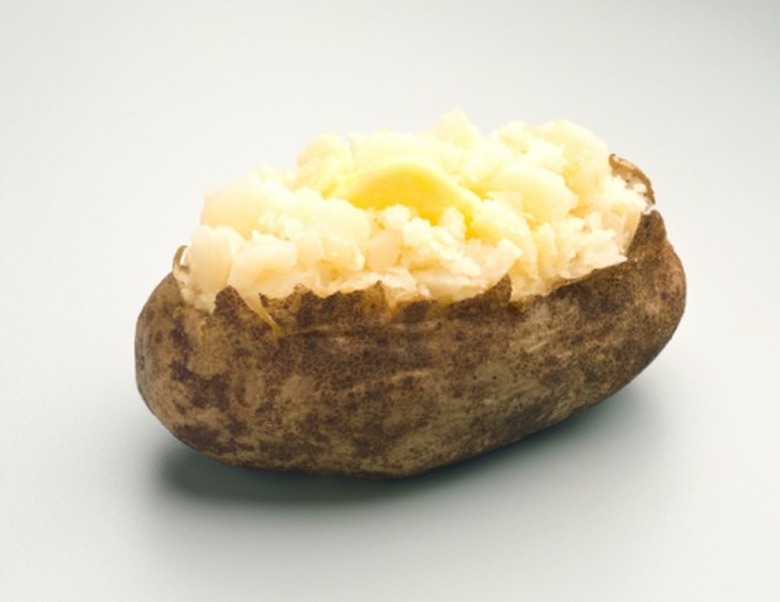Fun Science Experiments With Potatoes
Potato experiments help younger scientists to explore water solubility, natural reactions and electromagnets. Some experiments use water, while others need the help of aluminum foil. With some household items, fun science experiments with potatoes increase a child's understanding of how these processes work and allow them to create research projects for school.
Potato Clock
Potato Clock
In this experiment, you power a clock using potatoes as electrochemical cells that convert chemical energy into electrical energy.
First, you need two raw potatoes, two short lengths of copper wire, two galvanized nails, three alligator clips and a small single-battery LCD display digital clock. Take the battery out of the clock if there is one. Insert a nail into each potato. Push a length of wire into each potato far away from the nail. Attach one alligator clip to connect the copper wire of one potato to the positive terminal of the clock's battery compartment.
Attach the other alligator clip to connect the nail in the other potato to the negative terminal.
Attach the third alligator clip to connect the nail in the first potato to the copper wire in second potato. The LED clock powers on. Record how long the potatoes sustain energy to power the clock. In this potato battery experiment, the transfer of electrons moves between the zinc coating of the galvanized nail to the potato and copper wire, conducting electricity.
Floating Potatoes
Floating Potatoes
With a beaker and potato slices, this experiment tries to see how objects float in different water solutions.
First, you need water, 1-inch-thick potato slices, three beakers, stir rod or spoon, salt, sugar and food coloring. Fill one of the beakers until almost full, then put in a potato slice. Record what happened, such as whether the potato slice floats or not. Add salt to the next beaker of water, then place a potato slice in and record what happens.
For the last beaker, mix sugar into the water, then add a potato slice. The goal is to make one of the slices float, one sink and one suspend in the middle of the beaker. Keep track of how much salt or sugar you have to add to the water to get the potato slice to sink or suspend.
Potato Osmosis
Potato Osmosis
In this experiment, you fill two bowls halfway with water.
Slice two potatoes lengthwise into several pieces so that they are flat on each side. Add two tablespoons of salt to one of the bowls. Place half of the potato slices in the bowl with no salt, then place the rest in the bowl with salt. Allow the potatoes to soak for 20 minutes. Once finished, notice how different the sets of potatoes are.
In osmosis, water moves from areas of low salt concentrations to areas of high salt concentrations. Once you add salt to the water, you create a higher salt concentration in the water. Thus the potato soaking in salt water loses moisture, turning the potato into a mushy mess.
Potato Insulator
Potato Insulator
Gather insulating materials like aluminum foil, paper towels, plastic wrap and a cloth napkin. You also need potatoes and a thermometer.
This experiment tests to see what materials keep a potato warm the longest. First, poke a hole in the potato for the thermometer to fit inside the middle. Then heat the potato in a microwave oven for 10 to 15 seconds. Take the potato out and wrap it in one of the insulation materials, recording the time and temperature of the potato when you finish wrapping. Put the potato aside and heat up and wrap another potato. Continue until you have all of them wrapped in different insulation materials.
You also need to heat one potato and leave it uncovered. Record the times, watching as the potatoes change or remain hot. Once finished, write about which materials kept the potato the warmest.
References
- "Potato Chip Science: 29 Incredible Experiments"; Allen Kurzwell; 2010
Cite This Article
MLA
Adams, C.K.. "Fun Science Experiments With Potatoes" sciencing.com, https://www.sciencing.com/fun-science-experiments-potatoes-8216496/. 21 July 2017.
APA
Adams, C.K.. (2017, July 21). Fun Science Experiments With Potatoes. sciencing.com. Retrieved from https://www.sciencing.com/fun-science-experiments-potatoes-8216496/
Chicago
Adams, C.K.. Fun Science Experiments With Potatoes last modified August 30, 2022. https://www.sciencing.com/fun-science-experiments-potatoes-8216496/
